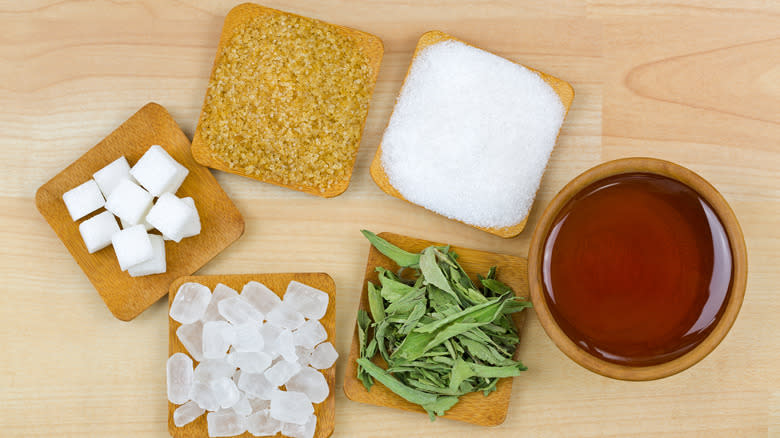A Sweet Touch Is The Easiest Way To Fix A Dish That's Too Spicy

No matter how much you love spicy food, there's always a chance of crossing that tenuous threshold between piquant and painful. Even one bite of an overly spicy dish will launch you beyond the eye-watering, tongue-singing point of no return. If you're left with a running nose and salivating mouth after an overzealous addition of spice, you can save what's left of your dish with a simple remedy you're likely to have in your pantry.
A dash of something sweet, whether it's sugar, honey, agave, or maple, is the easiest way to salvage an over-spiced dish. Spicy and sweet receptors exist on our tongue in different capacities; Sweet is one of the five major tastes detected by our tastebuds while spicy flavors are detected by pain receptors. By adding sugar to spicy food, we activate sweet receptors on our tongue which detracts from the spicy pain receptors, effectively balancing the two flavors. Other theories suggest that sugar molecules bind to capsaicinoid chemicals responsible for the painful heat.
Because spicy receptors have less to do with taste perception, sweetness neutralizes the heat without eliminating the underlying flavor of a spicy ingredient. For example, if you add too many chili peppers to your birria broth, a dash of sugar will help eliminate the uncomfortable burning sensation while enhancing the inherent flavor of the peppers themselves. Furthermore, you can add even more depth of flavor to your dish depending on the type of sweetener you use.
Read more: 21 Delicious Ways To Use Up Leftover Rice
Sweeteners To Temper And Enhance Different Spicy Dishes

Sweeteners come in many forms, and they all have distinct flavors depending on source and refinement. Consequently, different sweeteners will impart different flavors to the spicy dishes you add them to. However, this could be an opportunity to enhance the overall profile of a dish.
Maple syrup, for example, is sweet with distinctly rich-tasting notes you won't find in refined white sugar or high fructose corn syrup. Its flavorful addition to pork glazes would make it a great neutralizer for overly spiced pork dishes, from spicy Korean barbeque to Cajun andouille sausage dishes like gumbo or jambalaya.
Honey is another distinctly rich sweetener with botanical and floral notes. It's a classic additive to spicy dishes worldwide. Fancy pizza places will drizzle it over spicy pepperoni, Calabrian chilies, or jalapeno toppings. It also tempers the unique heat from mustard in vinaigrettes.
Brown sugar offers a wonderful depth of flavor to spicy meat and bean chili with too much cayenne and chili powder. Molasses would provide both sweet and bitter notes to neutralize a spicy dish. Of course, if you want a more neutral sweetness, white sugar, agave, and corn syrup are great options to temper spice without adding unique flavors.
Just as you should've done when adding spices to your stew, marinade, dip, or glaze, you should add sugar a small teaspoonful at a time to find the perfect balance.
Read the original article on Tasting Table.


